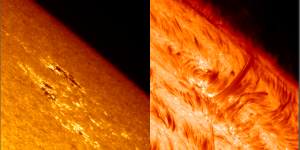We combine observations from both ground-based and space-borne instruments, for example the Swedish 1-metre Solar Telescope on La Palma and NASA’s Interface Region Imaging Spectrograph (IRIS) and Solar Dynamics Observatory (SDO) to disentangle various dynamical processes.
These combined datasets amount to large volumes of data with multiple dimensions (for example in the spatial, temporal, spectral, and polarization domains).
In this project, Deep Learning will be used to interpret these complex datasets. Training will be based on synthetic observables derived from large-scale numerical models of the solar atmosphere. These models are produced by Bifrost, a state-of-the-art radiative magneto-hydrodynamics code that can model large volumes of the solar atmosphere that covers the top of the convection zone, the photosphere, chromosphere, transition region and corona.
Requirements
- MSc in astrophysics, physics or a related field.
- Candidates with documented experience in machine learning will be prioritized.
Supervisors
Professor Luc Rouppe van der Voort
Associate Professor Tiago Pereira
Call 2: Project start autumn 2022
This project is in call 2, starting autumn 2022.
